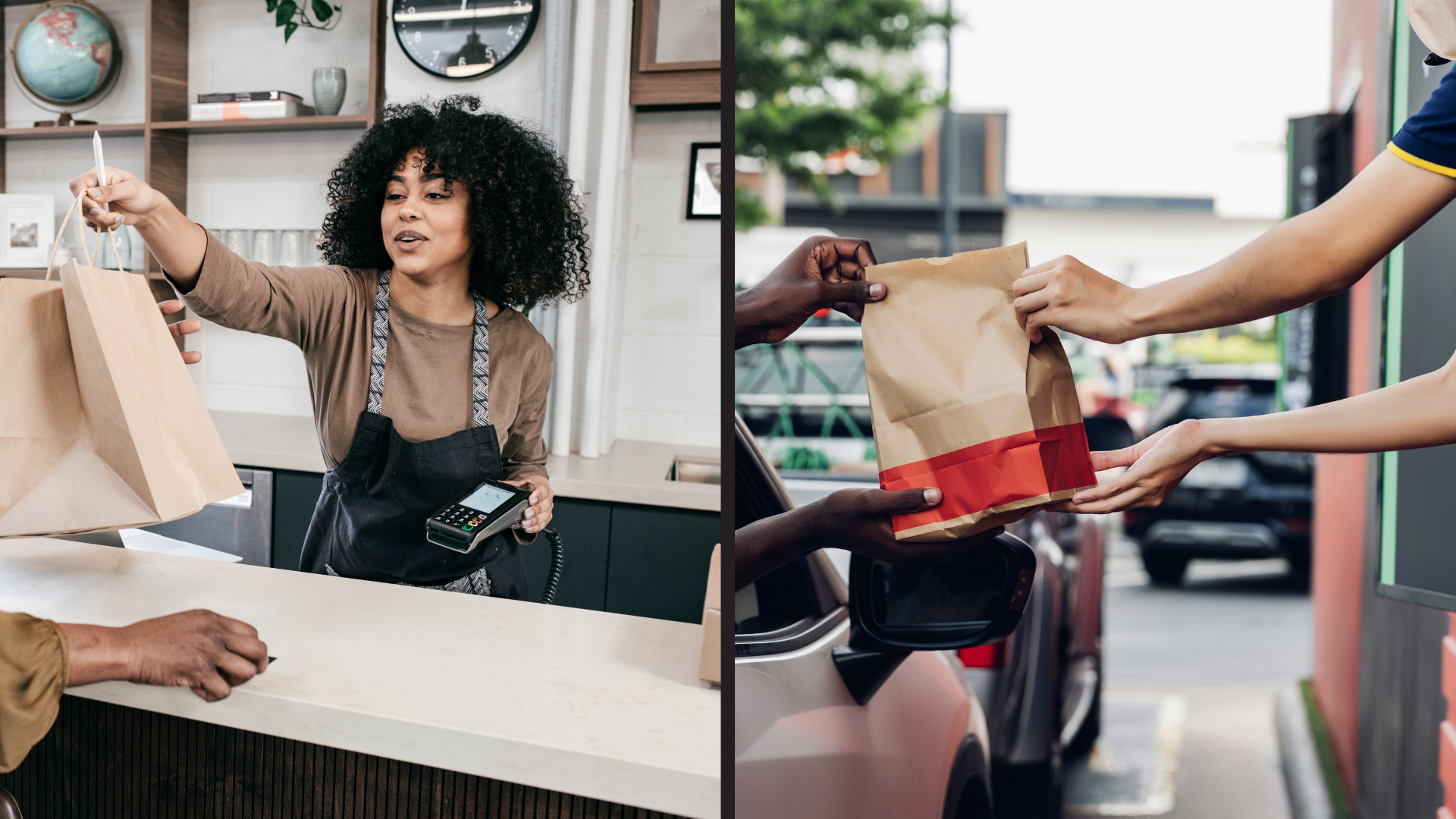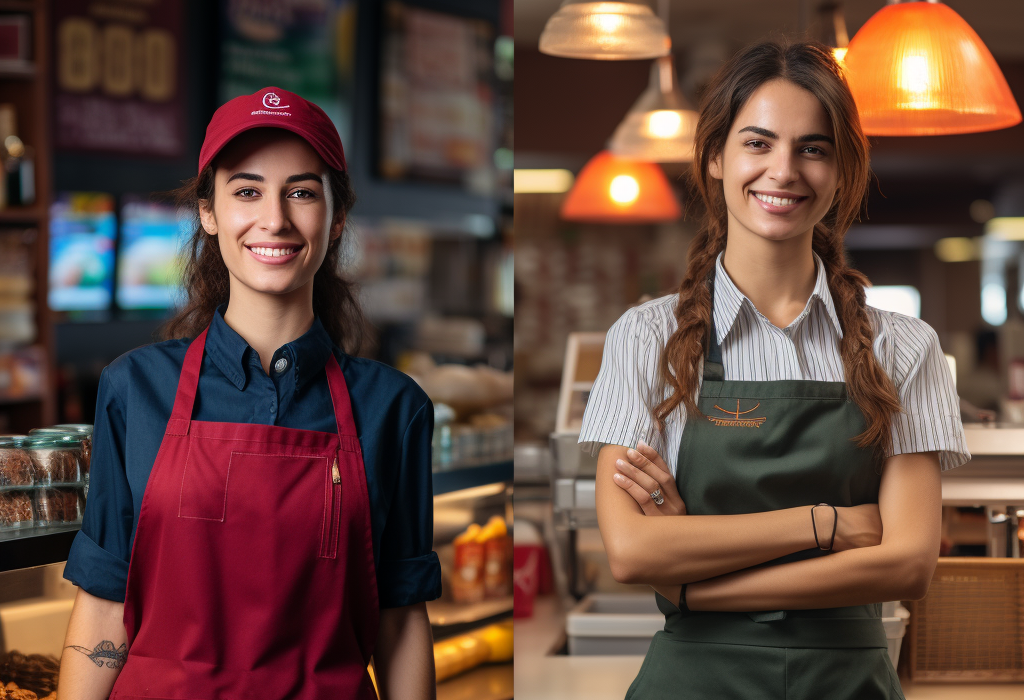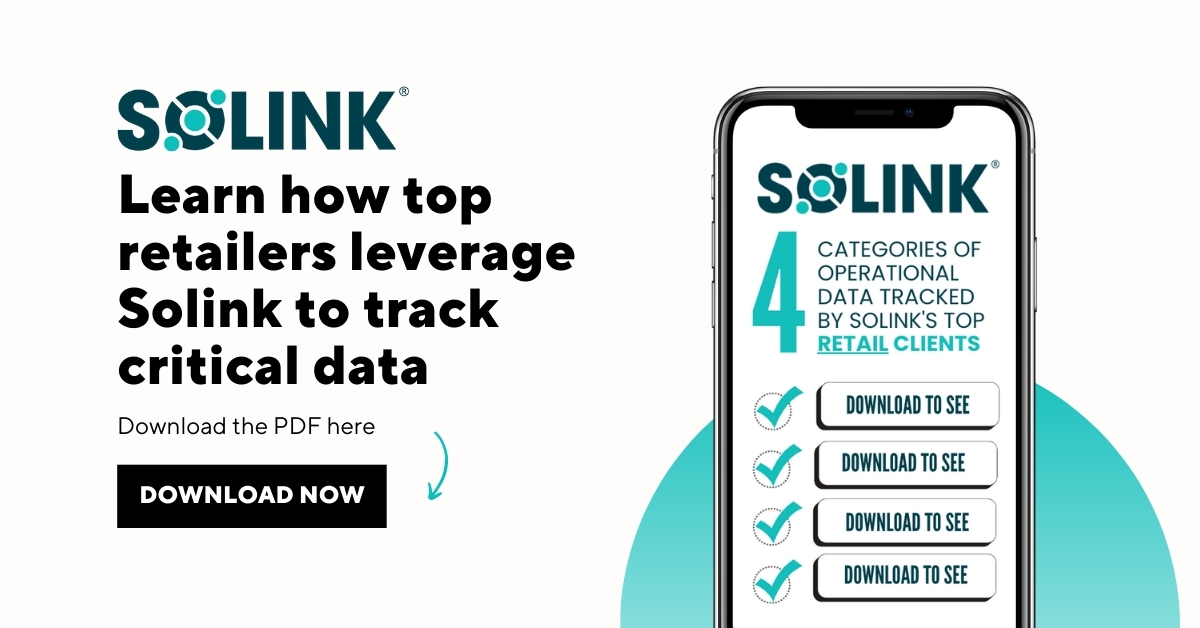Table of Contents
Table of Contents
Food service and retail both involve selling products to customers, but they operate very differently. From inventory management to customer interactions, each industry has unique challenges and requirements. If you’ve ever wondered, “Is fast food considered retail?” or “What’s the main difference between food service and retail?”, you’re not alone.
In this guide, we’ll break down the key differences between food service and retail, including business models, staffing, inventory, and customer experience. Whether you’re starting a business or exploring career options, understanding these distinctions can help you make informed decisions.
Retail industry overview
The retail industry has experienced significant shifts in recent years, influenced by evolving consumer behaviors and economic factors. In 2024, global retail sales reached approximately $30.6 trillion, marking a 4.37% increase from the previous year. In the United States, retail sales totaled $8.53 trillion in 2024, reflecting a 2.78% rise from 2023. E-commerce continues to play a crucial role, accounting for 15.4% of all U.S. retail sales in the first five months of 2024.
Despite overall growth, the industry faces challenges, including store closures. Over 13,000 high street stores closed in 2024, with projections for further closures in 2025. (thesun.co.uk)
Consumer preferences are also shifting. A recent survey revealed that Trader Joe’s and Publix tied for first place as American consumers’ favorite supermarket chains, each earning a satisfaction score of 84 out of 100. (realsimple.com)
These developments underscore the dynamic nature of the retail sector, highlighting the importance for businesses to adapt to changing market conditions and consumer expectations.

Food services industry overview
The global food service industry has demonstrated resilience and adaptability in recent years, navigating challenges such as the COVID-19 pandemic, shifting consumer preferences, and economic fluctuations. In 2024, the industry was valued at approximately $3.49 trillion and is projected to grow to $6.81 trillion by 2032, reflecting a Compound Annual Growth Rate (CAGR) of 7.79%. (fortunebusinessinsights.com)
One major driver of growth is technological integration. The widespread adoption of online ordering, delivery apps, and digital payment systems has enhanced convenience for consumers, making food service more accessible than ever. Another significant trend is the focus on health and wellness, with increasing demand for organic, plant-based, low-calorie, and gluten-free options. This shift is reshaping menus across various food service establishments.
Despite its growth, the industry faces labor shortages, with 23% of businesses struggling to find staff. Roles like chefs and cooks are particularly difficult to fill, making up 30% of open positions. Rising operational costs and economic uncertainty are also major concerns, with 47% of industry professionals citing increasing rent and fluctuating ingredient prices as key financial pressures.
Food service vs. retail FAQs
Below are some of the most frequently asked questions comparing these industries, covering everything from business models to profitability and economic impact.
1. Is fast food considered retail?
Fast food falls under the food service industry, not retail. While both involve selling products to consumers, food service focuses on preparing and serving food, while retail primarily deals with selling goods.
2. What is the biggest difference between retail and food service?
The biggest difference is inventory and operations. Retail focuses on selling physical products, often with longer shelf lives, while food service involves perishable inventory, food preparation, and strict health regulations.
3. Do retail and food service require different skill sets?
Yes, though both require customer service skills, food service jobs often require food handling, preparation, and safety knowledge, while retail jobs focus more on sales, merchandising, and inventory management.
4. Which industry has higher profit margins, retail or food service?
Profit margins vary, but retail generally has higher margins than food service. Restaurants often operate on lower margins (5-10%) due to food costs and waste, while retail stores can have margins between 20-50%, depending on the product.
5. Is it easier to start a retail business or a restaurant?
Retail businesses are generally easier to start because they don’t require commercial kitchens, food safety permits, or as much specialized labor. Restaurants have higher upfront costs and stricter regulations, making them more challenging to launch.
6. Can a business operate in both retail and food service?
Yes, many businesses combine both industries, such as grocery stores with prepared food sections or cafes selling retail coffee and merchandise. This hybrid model can increase revenue streams and attract more customers.
7. Which industry is more affected by economic downturns?
Food service is often more vulnerable during economic downturns, as dining out is seen as a discretionary expense. Retail, especially for essential goods like groceries and household items, tends to be more stable in tough economic times.
8. Do food service and retail have different peak seasons?
Yes, retail peaks during holidays (Black Friday, Christmas, back-to-school), while food service sees spikes during weekends, summer, and special events. However, both industries rely on seasonal trends to maximize sales.
Food service vs retail: Industry level differences (more details)
Both sectors have overarching differences at the macro level, determined by various factors:
- Market growth rate
- Barrier to entry
- Level of competition
- Market fragmentation
- Profit margins
- Supply chain complexities
- Seasonality effects
- Regulatory environment
- Industry life cycle stage
- Potential for digital transformation
- Required initial investment
- Consumer demand volatility
- Market saturation levels
- Average business lifespan
- Predominant business models
- Worker union influence
- Environmental impact considerations
- Technological innovation pace
- Cross-border expansion potential
- Average ROI (return on investment)
- Brand loyalty factors
- Price sensitivity
- Impact of online marketplaces
- Investment in advertising & promotion
- Business resilience during economic downturns
Market growth rate
The retail market’s growth is predominantly influenced by consumer spending patterns and technological advancements. On the other hand, the food service industry’s growth largely depends on dining habits and emerging dining concepts.
Barrier to entry
Retail often requires significant capital for inventory and storefronts. In contrast, food service, especially niches like pop-ups or food trucks, might have lower initial costs but challenges in brand differentiation.
Level of competition
Competition in retail is intense, with numerous players across various segments. Food service faces its own competition, especially in saturated urban areas, with trends and dining fads constantly evolving.
Market fragmentation
While retail has several giants dominating large market shares, numerous smaller players also exist. The food service industry, however, is more fragmented, with independent restaurants and cafes holding a significant market portion.
Profit margins
Retail, especially fast fashion and e-commerce, sometimes operates on slim margins due to fierce competition. Conversely, food services, depending on the establishment type and location, can either enjoy high margins or struggle with tight operational costs. Both industries rely on Solink to protect their profits.
Supply chain complexities
Retail’s supply chain intricacies involve global logistics, warehousing, and stock management. Food service, however, deals with perishable goods, requiring rapid turnover and stringent quality controls.
Seasonality effects
Retail sees pronounced seasonality, with spikes during holiday seasons and sales events. The food service industry also experiences seasonality, with certain cuisines or dishes becoming popular during specific times, and patios or holiday specials drawing crowds.
Regulatory environment
Retailers face regulations related to consumer rights, product safety, and imports. In contrast, food services contend with food safety standards, health inspections, and sometimes even licensing for alcohol or outdoor seating.
Industry life cycle stage
Retail, especially brick-and-mortar, is at a mature stage in many markets, with e-commerce ushering in new growth. Food service remains in growth mode in many regions, with constant evolution in dining formats.
Potential for digital transformation
Both sectors have embraced digitalization, but their approaches differ. Retail has adopted e-commerce, virtual fitting rooms, and AI-driven recommendations. Food service has seen a surge in online ordering, delivery apps, and tableside digital ordering systems.
Required initial investment
Opening a retail store necessitates investment in inventory, leasing, and store setup. Food service establishments may face higher initial costs for kitchen equipment, venue design, and licensing.
Consumer demand volatility
Retail can be influenced by fast-changing trends, especially in sectors like fashion. Food service demand can be affected by dietary trends, food scares, or even viral food fads.
Market saturation levels
Many urban areas are saturated with both retail stores and restaurants, leading to intense competition. However, unique value propositions or niche market targeting can still yield success.
Average business lifespan
Retail stores, especially big chains, might have longevity but also face risks from digital competition. Many restaurants face challenges in the initial years, with only the most resilient and adaptive ones thriving in the long run.
Predominant business models
While retail has models ranging from brick-and-mortar to purely online, hybrid models are becoming more common. Food service includes dine-in, takeaway, delivery, cloud kitchens, and pop-ups.
Worker union influence
In certain regions, retail workers are heavily unionized, impacting wage negotiations and work conditions. Food service workers, especially in larger establishments or chains, may also be unionized, affecting operational dynamics. Whether food service vs retail, Solink can help you save hours a day on loss prevention, case management, and more.
Environmental impact considerations
Retail, especially fast fashion, is under scrutiny for environmental concerns. Food service establishments are evaluating sustainable sourcing, waste management, and energy-efficient operations.
Technological innovation pace
Retail tech innovations include AR/VR, smart fitting rooms, and automated checkouts. Food service tech encompasses POS advancements, kitchen automation, and customer experience enhancements.
Cross-border expansion potential
Retail brands often expand internationally, adapting to local preferences. Food service, especially successful chains, also venture abroad, tweaking their menus for local palates.
Average ROI (return on investment)
Retail ROI depends on factors like location, product type, and market demand. Food service ROI is influenced by venue location, menu pricing, and operational efficiency.
Brand loyalty factors
Retail brand loyalty might be driven by product quality, pricing, or brand image. For food service, taste, dining experience, and service quality play pivotal roles.
Price sensitivity
Retail consumers, especially in segments like electronics or fashion, can be highly price-sensitive. In food service, while price matters, the overall dining experience can justify premium pricing for some consumers.
Impact of online marketplaces
Online marketplaces have disrupted traditional retail, offering consumers variety and convenience. In food service, aggregator platforms have transformed how we order and get food delivered.
Investment in advertising & promotion
Both sectors invest heavily in advertising. Retail focuses on product launches, sales events, and brand building, while food service might emphasize promotional deals, new menu items, or ambiance.
Business resilience during economic downturns
Economic downturns can lead to reduced discretionary spending, impacting both sectors. However, essentials in retail might still see steady sales, while food service might pivot to more value offerings or delivery models.
Food service vs retail: Store level differences (more details)
At the ground level, the nuances between a retail store and a restaurant are evident in daily operations and customer interactions:
- Average store/restaurant size
- Startup costs
- Inventory management requirements
- Staffing requirements
- Customer service expectations
- Peak business hours
- Frequency of inventory turnover
- Shelf-life of products/items
- Customer retention strategies
- Frequency of promotional offers
- Dependency on local suppliers
- Product/service diversification
- Point-of-sale system complexities
- Energy consumption patterns
- Average transaction value
- Space layout & design importance
- Necessity for specialized training
- Maintenance and cleanliness standards
- Customer feedback mechanisms
- Return and refund policies
- Loss prevention strategies
- Payment methods accepted
- Loyalty program prevalence
- Seasonal product/service variations
- Frequency of renovations or store refreshes
Average store/restaurant size
Retail stores range from compact kiosks to expansive superstores. Food service establishments, from cozy cafes to sprawling restaurants, also differ widely in size, impacting customer experience.
Startup costs
While both sectors have variable startup costs, opening a retail store might necessitate a substantial investment in inventory. A restaurant, however, may see higher initial expenses in kitchen equipment and licensing.
Inventory management requirements
Retail necessitates meticulous inventory management due to the range of products and their respective shelf lives. On the other hand, food service must manage perishable items, ensuring fresh produce without incurring wastage.
Staffing requirements
Retailers often require staff for sales, customer service, stock management, and cashier roles. Restaurants, cafes, and other food establishments need chefs, servers, bartenders, and often specialized roles based on their service model.
Customer service expectations
In retail, customers anticipate knowledgeable staff who can guide purchases. In food service, the emphasis is on timely service, courteous staff, and problem resolution.
Peak business hours
Retail peak hours often align with weekends or during sale events. Food service establishments see rushes during meal times, weekends, and holidays.
Frequency of inventory turnover
Retail items, depending on the segment, might have slower turnover rates. In contrast, the perishability of food items requires frequent inventory rotation.
Shelf-life of products/items
Retail products, especially non-perishables, have extended shelf lives. Food items, especially fresh produce and dairy, have limited shelf lives demanding efficient usage and replenishment.
Customer retention strategies
Retailers deploy loyalty programs, discounts, or exclusive previews. Restaurants might offer loyalty points, special menu items, or member-only events.
Frequency of promotional offers
Sales and discounts are periodic in retail, often season-driven. Food services might introduce daily specials, happy hours, or limited-time offers.
Dependency on local suppliers
Retailers might have global supply chains, especially for branded goods. Many restaurants emphasize locally-sourced ingredients for freshness and to support local communities.
Product/service diversification
Retailers often diversify product ranges to cater to broader audiences. Restaurants may diversify menus, introduce themed nights, or even add entertainment to enhance their service offering.
Point-of-sale system complexities
Retail POS systems handle diverse products, loyalty schemes, and return policies. In food service, POS systems must manage table reservations, split bills, and kitchen order tracking. Solink pairs POS data with video to help protect against employee theft.
Energy consumption patterns
Retailers, especially large stores, have consistent energy needs. Restaurants, with kitchen equipment and varied operational hours, have unique energy consumption patterns.
Average transaction value
Retail transaction values vary widely based on the store type and product category. Food service establishments see variations based on cuisine, location, and service type.
Space layout & design importance
Retail space design influences buying behavior and product discoverability. Restaurant layouts impact ambiance, customer flow, and dining experience.
Necessity for specialized training
Retail staff training focuses on product knowledge, POS handling, and customer service. Food service training often encompasses culinary skills, food safety, and service etiquette.
Maintenance and cleanliness standards
Retail cleanliness ensures product presentation and customer comfort. In food service, cleanliness is paramount for health standards and customer perception.
Customer feedback mechanisms
Retailers might have feedback forms, online reviews, or suggestion boxes. Restaurants often solicit feedback post-meal, through online platforms, or comment cards.
Return and refund policies
Retailers often have established return policies, especially for defective or unsatisfactory products. Restaurants handle dissatisfaction on-the-spot, offering replacements or discounts.
Loss prevention strategies
Retail focuses on preventing shoplifting and cashier errors. Food service loss prevention is about reducing waste, preventing pilferage, and efficient resource use. Here, Solink provides significant assistance by offering robust security and insights to reduce losses.
Payment methods accepted
Most retailers and food establishments now accept a mix of cash, cards, mobile payments, and even digital wallets.
Loyalty program prevalence
Retail loyalty programs offer points, discounts, or member-only benefits. Food services might offer meal points, free dishes, or exclusive previews. Be careful to watch out for employees taking advantage of these programs with discount abuse.
Seasonal product/service variations
Retailers introduce seasonal products, especially in fashion, decor, and electronics. Restaurants adjust menus seasonally, emphasizing fresh, in-season ingredients.
Frequency of renovations or store refreshes
Retail spaces might undergo occasional revamps to align with branding or market trends. Restaurants renovate to refresh the ambiance, repair wear and tear, or to stay current.
Solink can help food service and retail businesses alike
Both the food service and retail sectors benefit immensely from the integration of technology, data analytics, and enhanced security. Solink stands at the intersection of these needs, providing businesses with cloud video security, loss prevention tools, and invaluable insights into operations.
Leveraging Solink’s offerings not only fortifies business security but also aids in optimizing operations, ensuring both industries can thrive in today’s dynamic market landscape.
To see how Solink helps both the food service industry and retailers, sign up for a demo today.


